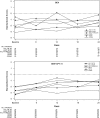Neurocognitive function in patients with recurrent glioblastoma treated with bevacizumab
- PMID: 21558074
- PMCID: PMC3107095
- DOI: 10.1093/neuonc/nor024
Neurocognitive function in patients with recurrent glioblastoma treated with bevacizumab
Abstract
Neurocognitive decline is a frequent adverse effect of glioblastoma. Antitumor therapies that are efficacious, as measured by traditional endpoints such as objective response (OR) and progression-free survival (PFS), and have beneficial effects on neurocognitive function (NCF) are of clinical benefit to these patients. We evaluated neurocognitive changes across time in 167 patients with recurrent glioblastoma treated with bevacizumab-based therapy in BRAIN, a phase II, randomized, multicenter trial. All patients underwent MRI and neurocognitive testing at baseline and every 6 weeks thereafter. Memory, visuomotor scanning speed, and executive function were evaluated using the Hopkins Verbal Learning Test-Revised, the Trail Making Test, and the Controlled Oral Word Association test, respectively. NCF relative to baseline for patients with an OR, PFS >6 months, or disease progression was evaluated at time of OR, 24 weeks, and time of progression, respectively. For patients with an OR or PFS >6 months, median standardized test scores were examined from baseline to week 24. Most patients with an OR or PFS >6 months had poorer NCF performance compared to the general population at baseline and had improved or stable NCF at the time of response or at the 24-week assessment, respectively; most patients with progressive disease had neurocognitive decline at the time of progression. For patients with an OR or PFS >6 months, median standardized test scores were largely stable across the first 24 weeks on study. Neurocognitive testing was an objective, valid, and feasible method of monitoring NCF in patients with recurrent glioblastoma.
Figures


Comment in
-
Neurocognitive function: an emerging surrogate endpoint for neuro-oncology trials.Neuro Oncol. 2011 Jun;13(6):565. doi: 10.1093/neuonc/nor065. Neuro Oncol. 2011. PMID: 21636704 Free PMC article. No abstract available.
Similar articles
-
Recurrent glioblastoma: volumetric assessment and stratification of patient survival with early posttreatment magnetic resonance imaging in patients treated with bevacizumab.Cancer. 2013 Oct 1;119(19):3479-88. doi: 10.1002/cncr.28210. Epub 2013 Jul 2. Cancer. 2013. PMID: 23821555
-
Influence of Residual Disease Following Surgical Resection in Newly Diagnosed Glioblastoma on Clinical, Neurocognitive, and Patient Reported Outcomes.Neurosurgery. 2019 Jan 1;84(1):66-76. doi: 10.1093/neuros/nyy003. Neurosurgery. 2019. PMID: 29618054 Free PMC article.
-
Salvage therapy with single agent bevacizumab for recurrent glioblastoma.J Neurooncol. 2010 Jan;96(2):259-69. doi: 10.1007/s11060-009-9957-6. Epub 2009 Jul 11. J Neurooncol. 2010. PMID: 19593660 Clinical Trial.
-
Hypertension as a biomarker in patients with recurrent glioblastoma treated with antiangiogenic drugs: a single-center experience and a critical review of the literature.Anticancer Drugs. 2013 Jan;24(1):90-7. doi: 10.1097/CAD.0b013e32835aa5fd. Anticancer Drugs. 2013. PMID: 23075631 Review.
-
Bevacizumab for recurrent glioblastoma: a systematic review and meta-analysis.Eur Rev Med Pharmacol Sci. 2021 Nov;25(21):6480-6491. doi: 10.26355/eurrev_202111_27092. Eur Rev Med Pharmacol Sci. 2021. PMID: 34787852
Cited by
-
Early measures of cognitive function predict survival in patients with newly diagnosed glioblastoma.Neuro Oncol. 2012 Jun;14(6):808-16. doi: 10.1093/neuonc/nos082. Epub 2012 Apr 16. Neuro Oncol. 2012. PMID: 22508762 Free PMC article.
-
Prolonged survival after bevacizumab rechallenge in glioblastoma patients with previous response to bevacizumab†.Neurooncol Pract. 2017 Mar;4(1):15-23. doi: 10.1093/nop/npw004. Epub 2016 Dec 9. Neurooncol Pract. 2017. PMID: 31385992 Free PMC article.
-
Verbal Learning Processes in Patients with Glioma of the Left and Right Temporal Lobes.Arch Clin Neuropsychol. 2016 Feb;31(1):37-46. doi: 10.1093/arclin/acv064. Epub 2015 Nov 3. Arch Clin Neuropsychol. 2016. PMID: 26537777 Free PMC article.
-
Neurocognitive, symptom, and health-related quality of life outcomes of a randomized trial of bevacizumab for newly diagnosed glioblastoma (NRG/RTOG 0825).Neuro Oncol. 2021 Jul 1;23(7):1125-1138. doi: 10.1093/neuonc/noab011. Neuro Oncol. 2021. PMID: 33515019 Free PMC article. Clinical Trial.
-
Dose-dense temozolomide for newly diagnosed glioblastoma: a randomized phase III clinical trial.J Clin Oncol. 2013 Nov 10;31(32):4085-91. doi: 10.1200/JCO.2013.49.6968. Epub 2013 Oct 7. J Clin Oncol. 2013. PMID: 24101040 Free PMC article. Clinical Trial.
References
-
- Meyers CA, Hess KR, Yung WK, Levin VA. Cognitive function as a predictor of survival in patients with recurrent malignant glioma. J Clin Oncol. 2000;18:646–650. - PubMed
-
- Giovagnoli AR, Silvani A, Colombo E, Boiardi A. Facets and determinants of quality of life in patients with recurrent high grade glioma. J Neurol Neurosurg Psychiatry. 2005;76:562–568. doi:10.1136/jnnp.2004.036186. - DOI - PMC - PubMed
-
- Farace E, Shaffrey ME. Relationship of neurocognitive impairment to QOL in malignant brain tumor patients. Society for Neuro-Oncology Fifth Annual Meeting: November 9–12, 2000; Chicago, IL: 2000. Abstract 61.
-
- Meyers CA, Boake C. Neurobehavioral disorders experienced by brain tumor patients: Rehabilitation strategies. Cancer Bull. 1993;45:362–364.
-
- Tomaszewski FS, Cahn-Weiner DA, Harvey DJ, et al. Longitudinal changes in memory and executive functioning are associated with longitudinal change in instrumental activities of daily living in older adults. The Clinical Neuropsychologist. 2008;23:446–461. doi:10.1080/13854040802360558. - DOI - PMC - PubMed
Publication types
MeSH terms
Substances
Grants and funding
LinkOut - more resources
Full Text Sources
Other Literature Sources
Medical

